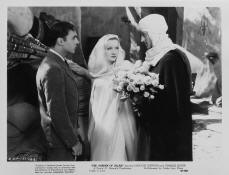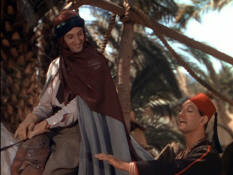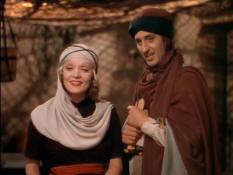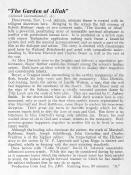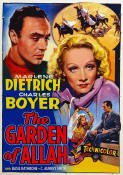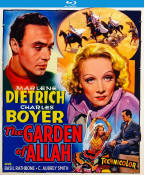The
Garden of Allah
|
| Anteoni: | "What can he hope to find?" |
| Androvsky: | "He can find joy, happiness." |
| Anteoni: | "Not for long. There must be anguish, despair." |
| Androvsky: | "No! Why?" |
| Anteoni: | "Because he knows inside himself that he has no right to the delights of the world." |
| Androvsky: | "Why? How can you judge? He has a right to love!" |
Soon Domini realizes that Boris is the monk who broke his vows and left the monastery. Boris was running away from the spiritual influence and Domini was seeking spiritual renewal. A strong believer in the importance of vows and commitments, Domini convinces Boris that he must make his sin right with God. Although she is heartbroken at the thought of parting from Boris, she insists that he go back to his religious life.
Together the lovers travel to the monastery and tearfully part at its gates.
|
Color photography has never appeared to greater advantage than in this picture in which vast expanse of golden desert, blue sky and flaming sunsets produce lovely pictorial backgrounds for the romantic action. The realistic effects are very beautiful, and the costumes of the natives and the varied hues of the flowing robes of Miss Dietrich blend in exquisite harmony with the settings. In fact, it is color which attracts greatest interest to the production. The story is dated. Twenty years ago it seemed daring romance. Today, audiences may find it difficult to be emotionally stirred because a Trappist monk breaks his vows, ventures into the world, samples its joys and then returns to the monastery for penance. The desert idyll is too far removed from modern life to seem real or important. Charles Boyer has a role in which an harassed conscience makes him constantly serious and darkly introspective. Miss Dietrich photographs to advantage in the medium, but a more emotional actress might have made the plot seem more vital. Joseph Schildraut as Batouch furnishes gay relief from the tragic action. Basil Rathbone, C. Aubrey Smith and Lucile Watson are exceptionally fine in important roles and Tilly Losch is impressive as a nautch girl. The musical accompaniment is noticeably good.
—Motion Picture Reviews, November 1936 |
Rathbone's character in this film is, as in the novel, a caring and sympathetic man; Rathbone eagerly accepted the role in order to get away from being typecast as a villain. In his autobiography, Rathbone tells how he came to blows with David Selznick, the producer, over how the character of Count Anteoni should be played. One morning Rathbone received some new pages of dialogue. "The situation and dialogue were such as to suddenly put Count Anteoni in a very unsympathetic situation and completely alter the course of characterization I had been developing. ... Selznick is not a man accustomed to arguments where he has made a prior decision, and the situation and dialogue had his O.K. ... I reminded David that I had signed a contract without reading a script and upon his assurance that Count Anteoni would be played exactly as written in Hitchins' book, and that the new scene was a gross infringement of this understanding" (In and Out of Character, page 148). Selznick threatened to press charges of insubordination against Rathbone with the Screen Actors Guild, so Rathbone eventually did the scene under protest. It's an interesting story, but I don't see anything in the film that puts Count Anteoni in an unsympathetic light, so I think we must assume that the scene that caused this trouble ended up on the cutting room floor.
Rathbone was also disappointed with the billing he received. In a letter dated December 2, 1936, Rathbone wrote to Sam Goldwyn, "I accepted Count Anteoni in The Garden of Allah without reading the script because David Selznick told me the story and the part as he told it was colourful & vital & important. We came to shoot it and it was nothing. In 'Allah' I was promised the same billing as John Barrymore got in Romeo and Juliet. I did not get it. This was my agent's fault. It was not in the contract & Mr. Selznick pointed out that it was not in the contract & would do nothing. So I was bunched down with Tilly Losh, Aubrey Smith and Schildkraut."
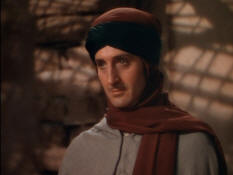 Count Anteoni observes Boris throw away his cross. |
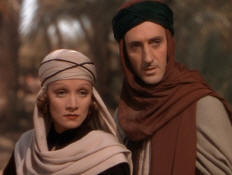 Domini and Count Anteoni are puzzled by Boris's behavior. |
In March 1936, Variety announced that Basil Rathbone would have a role in The Garden of Allah. It was also announced that Merle Oberon would play the role of Domini Entfilden.
Soon thereafter, Merle was removed from the cast of The Garden of Allah in favor of Marlene Dietrich. The newspapers circulated various rumors, including the following:
- Merle Oberon did not like the role and had begged to be released from her contract. (Oberon claimed that wasn't at all true.) Then a rumor circulated that
- Merle's color tests had shown that she did not photograph well in color. (Oberon claimed to have a telegram from an agent close to the producer that contradicted the rumor.)
- Merle was "bought off" by David O. Selznick at a cost of $25,000.
- Merle Oberon had turned down the lead in this film in favor of the lead in Dark Victory.
In April, Merle sued the studio for breach of contract. Motion Picture Herald (April 18, 1936) reported, "Merle Oberon sued Selznick International Pictures, Inc., in Los Angeles on Tuesday for $125,333.33 charging her reputation was damaged when another actress was substituted for her in the lead of 'The Garden of Allah,' now being made. Marlene Dietrich was substituted, but not named in the action. Miss Oberon said Selznick agreed to pay her $6,000 a week for 10 weeks and $1,000 a day thenceforth if the picture was not completed in 10 weeks. She charged that when she reported, the studio informed her another had been given the role."
The April 22, 1936 edition of Variety gives more details: "Asking damages of $125,333.33, Merle Oberon has filed suit in Superior court against Selznick international Pictures, Inc., charging breach of contract. Actress bases suit on her replacement as the lead in company's 'Garden of Allah' by Marlene Dietrich, after makeup tests, wardrobe fittings and publicity interviews. Complaint asserts that actress was signed by Selznick to do picture from story based on life of Florence Nightengale, alternate story to be selected by producer. With 'Nightingale' under production at Warners, 'Garden of Allah' was chosen as alternate film, suit charges, with Miss Oberon agreeing to postponement of start until April 1. Meanwhile producer was paying her $2,000 weekly during March, to cover the delay. On April 1, actress charges, she was informed she was to be starred in 'Dark Victory.' Miss Oberon alleges she was damaged to extent of $86,000, plus $50,000 general damages. Of total amount asked $10,666.67 has been paid, according to complaint."
The case dragged on for years. Merle Oberon finally dismissed it on March 11, 1940.
|
With subtle, flattering Technicolor handy to carry the load until the story takes hold, Garden of Allah emerges as a beautiful film forcefully portraying the struggle of two lost souls seeking happiness. Slow to unfold its highly abstract story, the picture wins contentment from any audience with spectacular color views of the desert coupled with a moving musical score. Once the familiar tale reaches the point of a safari into the desert, technical difficulties smooth out and the two principals, Marlene Dietrich and Charles Boyer, promptly win the utmost sympathy of the audience. Boyer is the monk who has abandoned his vows of isolation and silence, only to find happiness a fleeting thing never to be attained. Miss Dietrich's unhappiness is not so clearly motivated, but matters little when the two seek Futilely to solve their problems by marriage. Technicolor brings out all the gorgeous beauty of Miss Dietrich, makes her a vision of utter loveliness. Boyer, who looks natural enough in color, has greater opportunity for character delineation and succeeds in tugging at the emotional strings of his audience. Go to the theatre prepared for a story that deals with mental conflicts rather than physical, and you will not be disappointed. Garden of Allah emerges largely as an intellectual challenge, amply fulfills it s purpose at the climax. Whether or not you will agree with the studio's neat adaptation of an old motto—"Allah, be praised!"—you will find the picture worth your time and money. You will enjoy Basil Rathbone in a role that is not villainous, and you will be thoroughly impressed with Joseph Schildkraut, playing the part of Marlene's amiable guide who occasionally likes to burst into fits of poetry. —Hollywood, January 1937 |
Much of the action in The Garden of Allah was filmed among the sand dunes near Yuma, Arizona, where regularly the thermometer registered 120 degrees in the shade, 140 to 148 in the sun. For eight weeks a sweating (and perhaps swearing) location crew struggled with heavy equipment, shifted reflectors, hauled on ropes and pulleys, heaved at laden trucks, plowing through the sand, and performed inhuman labors in connection with the outdoor sequences.
Not only the technical workers, cameramen, electricians and others, but also the film's stars were subjected to a grueling ordeal, working under a sun that would put the Sahara sun in the shade. Marlene Dietrich twice succumbed to heat prostration. Similar casualties among the hardy workmen were of daily occurrence. Even a camel that had accompanied the cast and crew to Yuma fainted from sunstroke in the desert.
The heat caused real problems for the make-up crew. The glue holding Boyer's toupee in place melted, causing it to slide down his face. In a non-heat-related incident during on-location filming, Marlene Dietrich injured her foot.
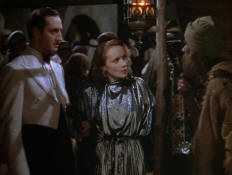 While exploring the bazaar Count Anteoni and Domini encounter the sand diviner. |
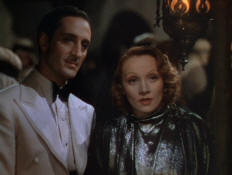 Count Anteoni translates what the sand diviner says. |
The press book tells us that the principal members of the cast had accommodations in Yuma. For housing most of The Garden of Allah company, a tent city sprang into being in the desert. The tent city was completely equipped for community life—with commissary, barber shops, showers, swimming pools, laboratories, dressing rooms, recreation halls, cooling equipment, etc. It was necessary also to construct elaborate sets representing Algerian villages, and oases dotted with date palms, necessitating a literal irrigation of that portion of the Arizona desert.
Months of advance preparation were necessary before the troupe could move into location. Location scouts were first sent to scout the desert areas of the West long before the scenario was completed. The first move under construction superintendent, Harold Fenton, was the erection of a small city of more than 50 tent-cabins as living quarters for the troupe of 200, who were to live there for several weeks. This was followed by the organization of community utilities and comforts. Tents were equipped with hot and cold water, electricity, modern plumbing, showers and conventional furnishings. A recreational hall was built and equipped for various games and diversions. Arrangements were made for a nightly showing of motion pictures and the newest projection equipment installed.
Transportation problems were varied. The location crew had to arrange to handle not only the enormous quantities of supplies and equipment but to move people promptly to and from location. This required a fleet of 34 sedans, trucks, busses and, for special desert work, a caterpillar tractor. Every day an impressive caravan moved from the camp into the desert with lighting equipment, properties, costumes, medical supplies, accessories of all sorts, quantities of building materials, platforms cameras, film and numberless appurtenances of picture making.
Vast quantities of materials were used in constructing the five largest desert settings. Heading the items needed for construction were 125,000 feet of lumber. Other materials were 3500 adobe bricks, 250 sacks of plaster, 60 kegs of nails, 1500 yards of burlap, 200 sheets of Celotex, 25 palm trees and other bulky articles. For one location, nearly a mile off the highway, it was necessary to construct over the sand a plank road which required an additional 95,000 feet of lumber and 45 kegs of spikes.
|
A delicate, intimate theme is treated with intelligent discretion here. Bringing to the screen the full essence of Robert Hichens' study of two tortured souls, "The Garden of Allah" tells a powerful, penetrating story of immutable spiritual allegiance in conflict with predestined human love. It is produced on a lavish scale with expert Technicolor application making each frame a beautiful picture and with the musical accompaniment just as much a part of the film as the dialogue and action. The story is directed with consummate good taste by Richard Boleslawski and acted with sympathetic understanding by Marlene Dietrich and Charles Boyer as well as the rest of the cast. As Miss Dietrich rises to the heights and delivers a superlative performance, Boyer further establishes himself among the screen's leading actors. Both have an ideal vehicle in which to display their respective and considerable talents. Boyer, a Trappist monk succumbing to the earthly temptations of the flesh, breaks his holy vows and flees the monastery. Miss Dietrich, God-fearing, heeds the advice of Lucille Watson, a nun, that she will find happiness in the sanctuary of the desert. She and Boyer meet on the edge of the Sahara, where a vividly executed passion dance by Tilly Losch sets the soul of both afire. They are married by C. Aubrey Smith. In the desert-fabled Garden of Allah their ecstatic love is consummated, only to crash in the dust when earthly forces, represented by Alan Marshall and Basil Rathbone, cause Boyer to confess his monstrous deception. Their great joy turns to horrible tragedy which for the moment impels both to defy the laws of man and God. But there is no bitterness in Miss Dietrich's being, only sublime joy. Boyer, his soul washed clean of sin to God and woman, returns to the monastery. Both envision greater happiness together in another life to be lived in some future world. Although the leading roles dominate the picture, the work of Marshall, Rathbone, Smith, Joseph Schildkraut, John Carradine and Charles Waldron is of the highest caliber. The transcription of the Hichens' story to the screen by W. P. Lipscomb and Lynn Riggs is sincere and dignified, wholly in keeping with the most exacting standards. Once before with "Little Women" David O. Selznick measurable influenced screen trends. While this may be considered daring by some, as it concerns topics which the industry in recent years has been careful to avoid, the honest straight-forward manner in which he has handled the subject indicates that he may do so again. —Motion Picture Daily, November 2, 1936 |
Boris and Domini first realize they are in love at a beautiful oasis with a pool. This setting was erected among the rolling dunes in the open desert. The water for the pool was transported six miles in tank trucks from the pumping station of an irrigation canal.
An entirely different character of location and construction was required for the setting of Sidi-Zerzour, a large oasis where the young lovers first met Count Anteoni. The location was found ten and one-half miles off the main highway between Bard's and Laguna Dam, near the Arizona-California line. The roads leading in were rutty and full of holes. It was very difficult to reach with the heavy equipment.
Because the location is on the edge of the desert at the very limit of the reach of irrigation waters, it was necessary to re-landscape about three acres, changing the bed of the irrigation canal so that it became a rivulet flowing into a small lagoon. The main building on the oasis was a house with a flagged patio. Simple enough as a construction project, it became a serious undertaking on account of difficult haulage of materials. Beyond the set, a line of dressing rooms, make-up tents and wardrobes was erected. The building required the services of 40 men for a period of three weeks in advance of the company's arrival.
The most spectacular setting of any of the desert locations was an entire section of an Algerian city. It was situated in Buttercup Valley, near Gray's Wells, California, a saucer-like formation entirely surrounded by mountains of sand. This was the locale that was reached by the plank road, built of 2 by 4 surface timbers laid on a foundation of 4 by 6 pieces.
In the lower stretch of the valley, corrals were built for horses, camels, donkeys, dogs, goats, sheep, rabbits and chickens with bunk houses for the tenders. Back of the set were built tents and shacks. These consisted of dressing rooms, a school house for the children who worked in The Garden of Allah, a large wardrobe tent, make-up tent, storeroom for props and a cabin for camera equipment. The set itself was a square that opened from the narrow streets of Beni-Mora, lined with gray-balconied houses. In the square were grouped bazaars in colorful variety.
The magnificent shots of the sandstorm following Domini and Boris's wedding was a real sandstorm. The director was prepared to create one with wind machines, but nature stepped in and created a real storm. Director Boleslawski said, "It was glorious. ... We ruined two cameras and were all blinded, but we secured magnificent shots!" (Silver Screen, September 1936)
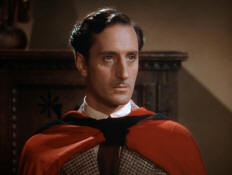 Count Anteoni observes the wedding ceremony of Domini and Boris. |
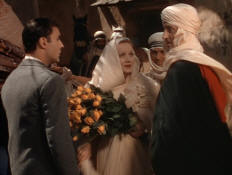 Count Anteoni wishes Domini and Boris well as they set out on their honeymoon. |
The Garden of Allah was filmed from April 15 to July 3, 1936. Budgeted at $1.6 million, the film ended up costing about $2 million. Time magazine (November 30, 1936) reported that the cost was $2,200,000.
One reason that the film went over budget was that it was made using the new, expensive three-strip Technicolor process. The Garden of Allah is one of the earliest films made using this process. W. Howard Greene and Harold Rosson won Academy Awards for their exquisite color photography, while composer Max Steiner and assistant director Eric Stacey received Academy Award nominations.
The film was released in New York City on October 15, 1936. General release in the USA was a month later, November 19, 1936.
Early reports were that the film was a box office success, but it ended up losing about $370,000.
The actors who were not speaking English babbled gibberish, trying to make it sound like Arabic. It didn't.
Although Basil Rathbone had worked with Richard Boleslawski on Broadway (Boleslawski directed Rathbone's own play Judas in 1929), The Garden of Allah was the only film Rathbone did with the director. Tragically, it was the 47-year-old director's final film; he died of a heart attack on January 17, 1937. The Film Daily (Jan. 19, 1937) reported that Basil Rathbone was one of the pallbearers at the funeral of Richard Boleslawski.
Basil had previously appeared in three films produced by David O. Selznick:
- David Copperfield (1935)
- Anna Karenina (1935)
- Tale of Two Cities (1935)
Two silent film versions of The Garden of Allah have also been made: in 1916 and in 1927.
Film clip: Count Anteoni makes his grand entrance.
See Page Two for more reviews and photos from the film. See Page Three for pictures of posters, lobby cards and promo photos.
.
|
.
|
The Garden of Allah is available
|
Images on this page and page two are from the film "The Garden of Allah," copyright Selznick International Pictures.







